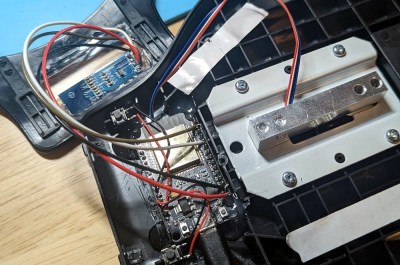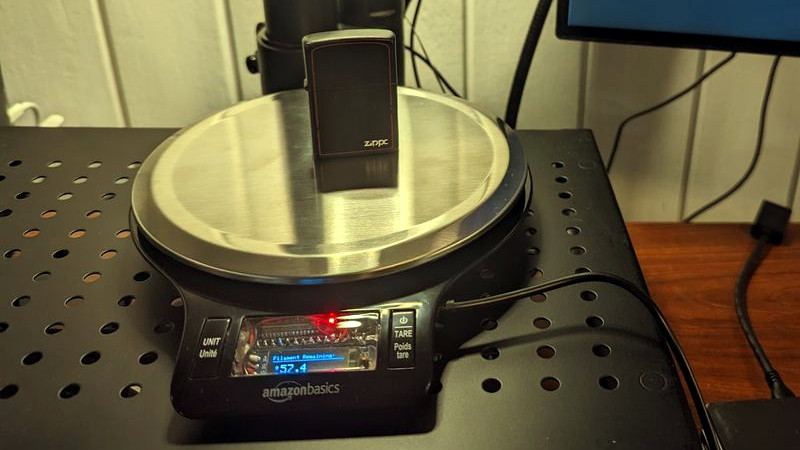Smart kitchen appliances are expensive, and more often than not, your usage data goes to whichever company operates the inevitable cloud service. Meanwhile the cheap ones contain substantially the same components without the smarts, so surely a hardware hacker can add a microcontroller to a cheap appliance for a bit of smart home technology without the privacy issues? It’s something [Liore] has done with an Amazon Basics kitchen scale, removing the electronics and wiring up an ESP32 to the load cell instead.
The Wheatstone bridge load cell circuit generates a tiny voltage difference that’s far too small for an ESP32 to measure, so in between the pair is an Avia Semiconductor HX711 strain gauge amplifier module. In addition, there’s a small OLED screen and the two buttons used in the Amazon scale are wired in too, providing the the kitchen scale functionality you’d expect.
 Naturally the ESP32 brings along with it WiFi networking capabilities, which [Liore] has taken full advantage of here. By navigating a web browser to its IP address, you’ll receive the scale’s current reading in JSON format. This should make it easy to integrate with other systems, from Home Assistant to OctoPrint. We can see that there is plenty of scope for further enhancements for those prepared to write a little code.
Naturally the ESP32 brings along with it WiFi networking capabilities, which [Liore] has taken full advantage of here. By navigating a web browser to its IP address, you’ll receive the scale’s current reading in JSON format. This should make it easy to integrate with other systems, from Home Assistant to OctoPrint. We can see that there is plenty of scope for further enhancements for those prepared to write a little code.
Of course, this isn’t the first enhanced scale we’ve brought you, here’s one with Bluetooth. We’ve also seen hackers dispense with the kitchen-safe trappings and build the load cell directly into their own contraptions.

















Instead of writing the code for homeassistant integration yourself, you can piggyback on esphome;
– hx711: https://esphome.io/components/sensor/hx711.html
– ssd1306: https://esphome.io/components/display/ssd1306.html
– ezbutton: https://esphome.io/components/button/index.html
– build in webserver: https://esphome.io/components/web_server.html
I guess a straightforward op-amp based voltage amplifier frontend would work in this application too?
Sure, stick a good bipolar chopper in there and you might be able to do better. But the HX711 is actually pretty darned good for this application (when implemented correctly anyway).
Though it’s got a noise figure near 10 dB, and is not very fast (10-80 Hz) I seriously doubt it’s possible to engineer a solution that performs any better for anywhere near the cost, and especially for the power draw.
Like any low-signal data acquisition task though, it’s pretty easy to degrade the performance of the HX711 through inept implementation.
I can see this also having a “target weight” function where there is a pulsing tone that gets faster and higher (and or a visual indicator such as a flashing LED that changes colour) as you get closer to a target that you had previously set via a web based interface. Would be nice to have a set of such targets matched to a recipe that you could step through in sequence. Because if you are going to make a thing smart you may as well make it as smart as possible with regard to what is possible with the code and data storage available on the device.
Great idea, coupled with a phone app and database of good recipes it could be a winner. One problem I always have (terrible at cooking) is recipes for same dish differ a lot in both ingredients and process making it very hard to find ones that match my (clumsy) style of cooking.